As an Amazon Associate KitchenwareSets.com earns from qualifying purchases.
11 Smart Empty Kitchen Wall Ideas For Style And Storage
Staring at that big, blank wall in your kitchen? You know it needs something, but the options feel overwhelming.
That empty space can make an otherwise cozy kitchen feel sterile and unfinished. It’s a common design problem that leaves many homeowners stuck.
The solution is to treat your empty kitchen wall as a canvas for both style and function. In this guide, you’ll discover 11 smart ideas to transform that blank space into a feature you love. Get ready to add personality and practical storage to the heart of your home.
Why Is That Empty Kitchen Wall So Hard to Decorate?
We’ve all been there—staring at a blank wall, knowing it needs something but not knowing where to start. This guide is born from that exact frustration. An empty kitchen wall presents a unique challenge because it must balance beautiful aesthetics with the room’s high-traffic, functional demands. It’s not just about hanging a picture; it’s about finding a solution that adds personality, warmth, and often, much-needed storage solutions.
The best empty kitchen wall ideas use materials that can withstand a kitchen’s heat and humidity, transforming a boring or awkward space into an intentional focal point. Decorating that blank wall isn’t a problem; it’s the final, personal touch that makes your kitchen design feel truly complete. This is your canvas of opportunity.
11 Smart Empty Kitchen Wall Ideas For Style And Storage
The following 11 ideas are your answer to that difficult blank wall. Curated based on timeless design principles like balance, scale, and functionality, these solutions are not just trendy but are proven to be effective. They range from simple DIY kitchen wall decor to hardworking storage solutions, ensuring there’s a perfect fit for every kitchen style, budget, and skill level. Let’s turn that empty space into your new favorite spot.
1. Create a Functional Gallery Wall
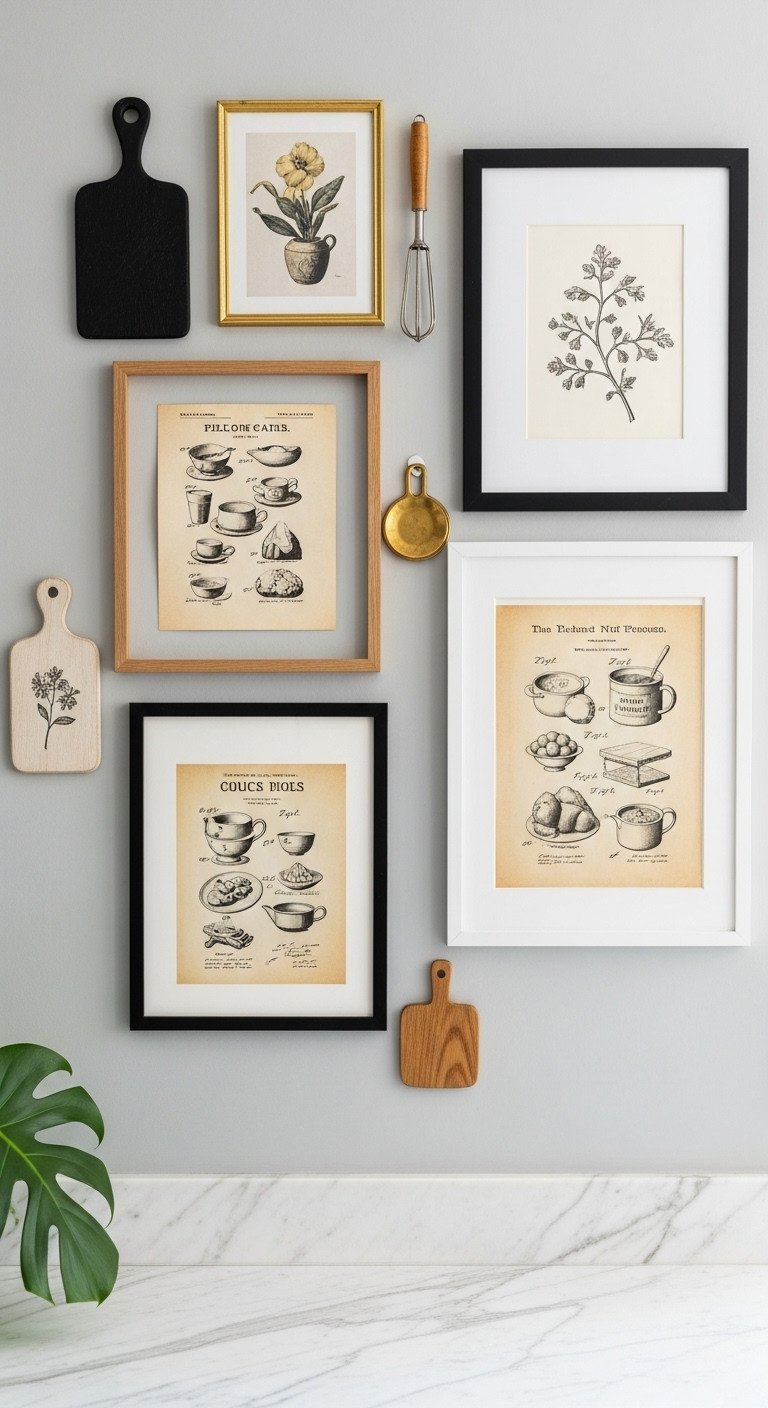
Pin this beautiful gallery wall idea for your kitchen!
A gallery wall is the perfect way to add personality and fill a large space with items you love. In the kitchen, you can mix food-themed art prints and family photos with small functional wall decor like a vintage utensil or a tiny hanging plant. This approach turns a blank wall into a personal story.
Materials Needed:
- A curated collection of frames in various sizes (e.g., black, wood, and metallic finishes)
- Art prints, family photos, or free printable kitchen-themed art
- A laser level for perfect alignment
- Picture hanging kit with assorted nails and hooks
- Small functional items like a hanging air plant or a vintage utensil
- Craft paper for creating layout templates
Step-by-Step Directions:
- Plan Your Layout: Trace each frame onto craft paper, cut them out, and arrange the paper templates on your wall with painter’s tape. Adjust until you love the composition.
- Maintain Balance: Start by placing your largest piece slightly off-center, then build the arrangement around it with smaller frames.
- Keep Spacing Consistent: Aim for 2-3 inches of space between each frame for a clean, cohesive look.
- Mark Your Spots: Once the layout is finalized, mark the nail spot directly through the paper templates.
- Hang Your Pieces: Remove the paper and install your hooks or nails. Hang your art, using the laser level to check your work as you go.
- Pro-Tip: Unify a mismatched collection of thrifted frames by painting them all in one or two coordinating colors from your kitchen’s color palette.
2. Install Rustic Open Shelving

Save this smart storage idea for your kitchen renovation!
Open shelving is a classic for a reason. It’s one of the best functional kitchen wall decor ideas, providing both valuable storage and a place to display your beautiful dishware. Rustic wood floating shelves can add warmth and texture, turning everyday ceramic plates and glassware into a curated display.
Materials Needed:
- 2-3 solid wood planks (e.g., pine, oak), cut to your desired length
- Set of heavy-duty floating shelf brackets or industrial pipe brackets
- A power drill with appropriate bits
- A stud finder (this is critical for safety)
- A laser level
- Wall anchors and screws suited for your wall type
Step-by-Step Directions:
- Find the Studs: Use a stud finder to locate the studs in your wall. This is where you will anchor the brackets for maximum support. Mark their locations with a pencil.
- Position the First Bracket: Hold your first bracket against the wall at your desired height, ensuring it’s on a stud mark. Use your level to make sure it’s straight. Mark the drill holes.
- Drill Pilot Holes: Drill pilot holes for your screws.
- Mount Brackets: Secure the first bracket to the wall. Position the second bracket, using the laser level to ensure it’s perfectly level with the first, and attach it to the wall.
- Attach the Shelf: Place your wood plank onto the brackets and secure it from below with smaller screws as per the bracket instructions.
- Style Your Shelves: Arrange your favorite dishes, glasses, and decor. Group items in threes and vary the heights for a balanced look.
- Lesson Learned: Don’t just rely on drywall anchors for kitchen shelves that will hold heavy dishes. Always anchor into studs for safety and long-term stability.
3. Hang a Statement Pot Rack
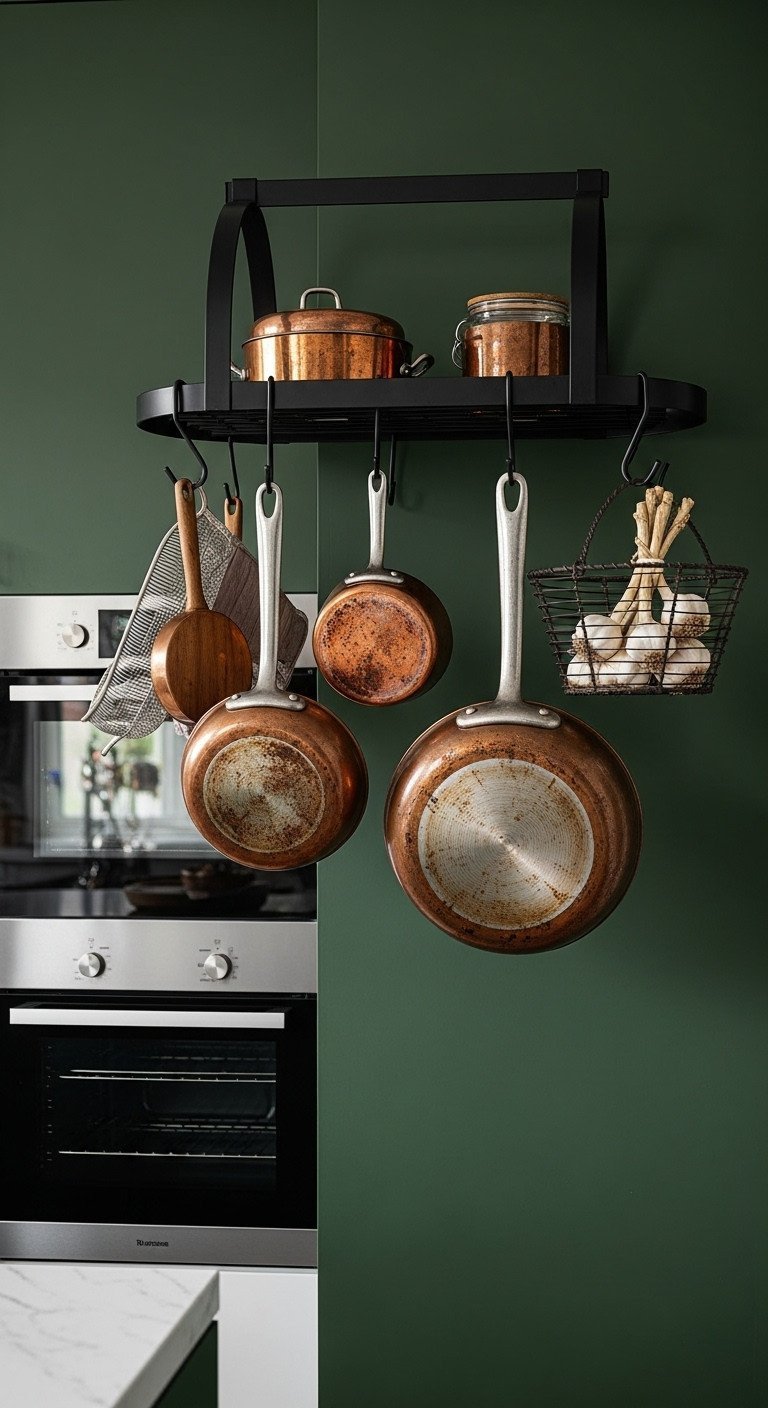
Pin this genius idea for saving cabinet space!
Free up precious cabinet space by moving bulky pots and pans to the wall. A wall-mounted metal pot rack provides accessible, vertical storage and doubles as industrial kitchen-style decor. It turns your cookware collection, especially beautiful copper or cast iron pieces, into a stunning focal point.
Materials Needed:
- A high-quality wall-mounted pot rack kit
- A stud finder (non-negotiable for this project)
- Power drill and appropriate drill bits
- Heavy-duty lag bolts (often included with the kit)
- A socket wrench set
- A level
Step-by-Step Directions:
- Choose Your Location: Select a wall space that is convenient to your stove but won’t be in a high-traffic path where someone could bump into the pans.
- Locate Studs: Use your stud finder to locate at least two studs where you will mount the rack. Mark them clearly. A pot rack loaded with cookware is extremely heavy and MUST be secured to studs.
- Mark Mounting Holes: Hold the pot rack’s mounting brackets against the wall over the stud locations. Use a level to ensure it’s straight, then mark the holes for the lag bolts.
- Drill Pilot Holes: Drill pilot holes into the center of the studs. The hole should be slightly smaller than the diameter of the lag bolts.
- Secure the Rack: Attach the rack to the wall using the lag bolts, tightening them securely with a socket wrench.
- Hang Your Cookware: Arrange your pots and pans on the S-hooks, placing your most-used items in the easiest-to-reach spots.
- Pro-Tip: A pot rack is functional decor. Hang your most beautiful cookware (like copper pans or colorful enamel) to turn your storage into a stunning visual feature.
4. Design a Dedicated Coffee Bar
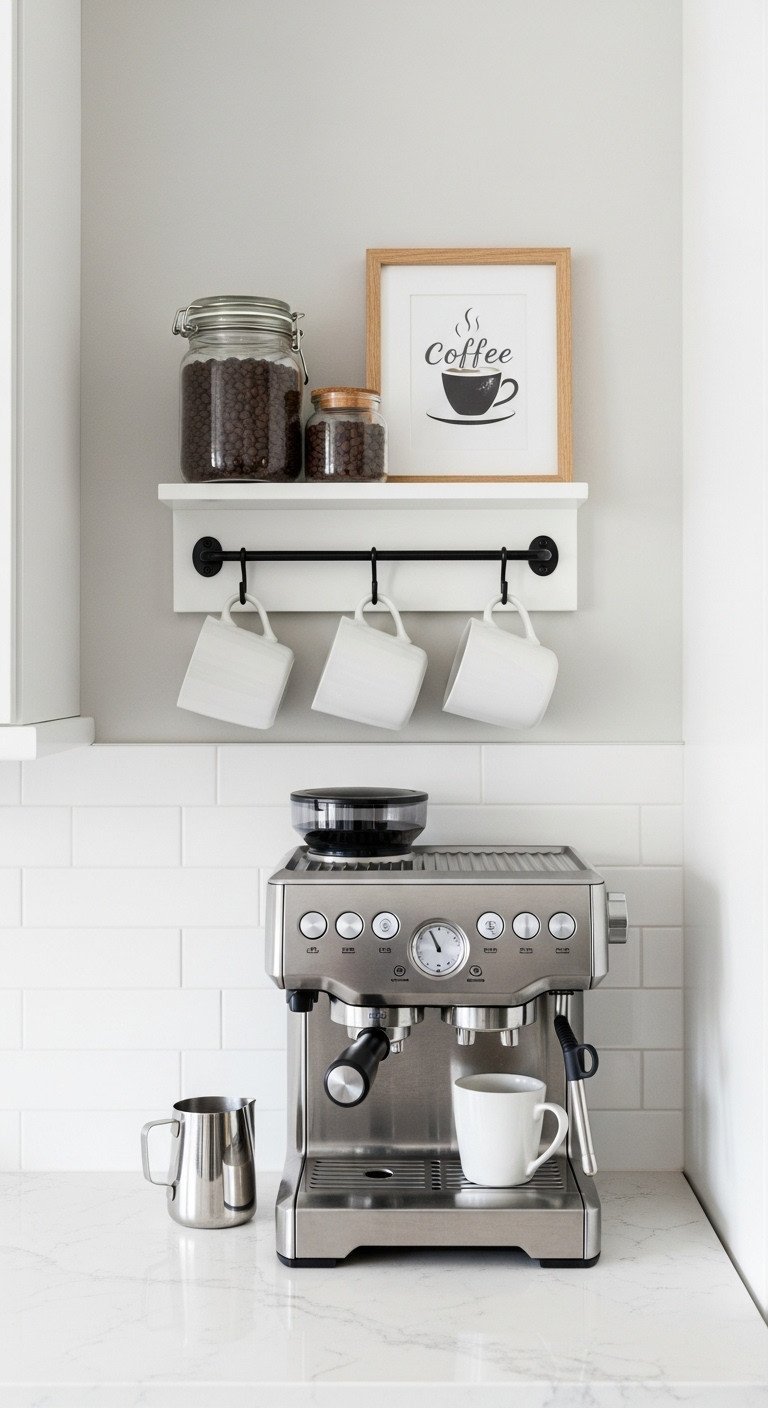
Save this dreamy coffee station idea for your morning routine!
Carve out a dedicated zone for your morning ritual. A coffee bar on an empty wall consolidates your coffee machine, ceramic mugs, and supplies into one stylish spot. Use a floating shelf with hooks and airtight glass canisters to keep everything organized and off your main countertops.
Materials Needed:
- One or two small floating shelves
- A shelf or rail with hooks for hanging mugs
- Canisters for coffee beans, sugar, and tea bags
- A small tray to contain accessories
- Optional: A small, framed art print or a letter board
- A stud finder, drill, and level for shelf installation
Step-by-Step Directions:
- Define Your Zone: Choose a section of your empty wall with counter space underneath it. This will be your coffee station.
- Install Vertical Storage: Mount a small floating shelf or two on the wall above the counter. Use a level to ensure they are straight.
- Add Mug Hooks: Install a rail with S-hooks or a shelf with built-in hooks underneath your main shelf. This is a great space-saver for your favorite mugs.
- Organize Your Supplies: Place your coffee maker on the counter below the shelves. Use canisters to store beans or grounds on the shelf, keeping them fresh and tidy.
- Style the Station: Arrange your mugs on the hooks. Use a small tray on the counter to hold your sugar bowl, spoons, and other small accessories. Add a small plant or a fun art print to complete the look.
- Pro-Tip: Use a tiered tray (like one for cupcakes) on the counter to add vertical storage for K-cups, sugar packets, and tea bags without taking up a large footprint.
5. Mount a Sleek Magnetic Knife Strip
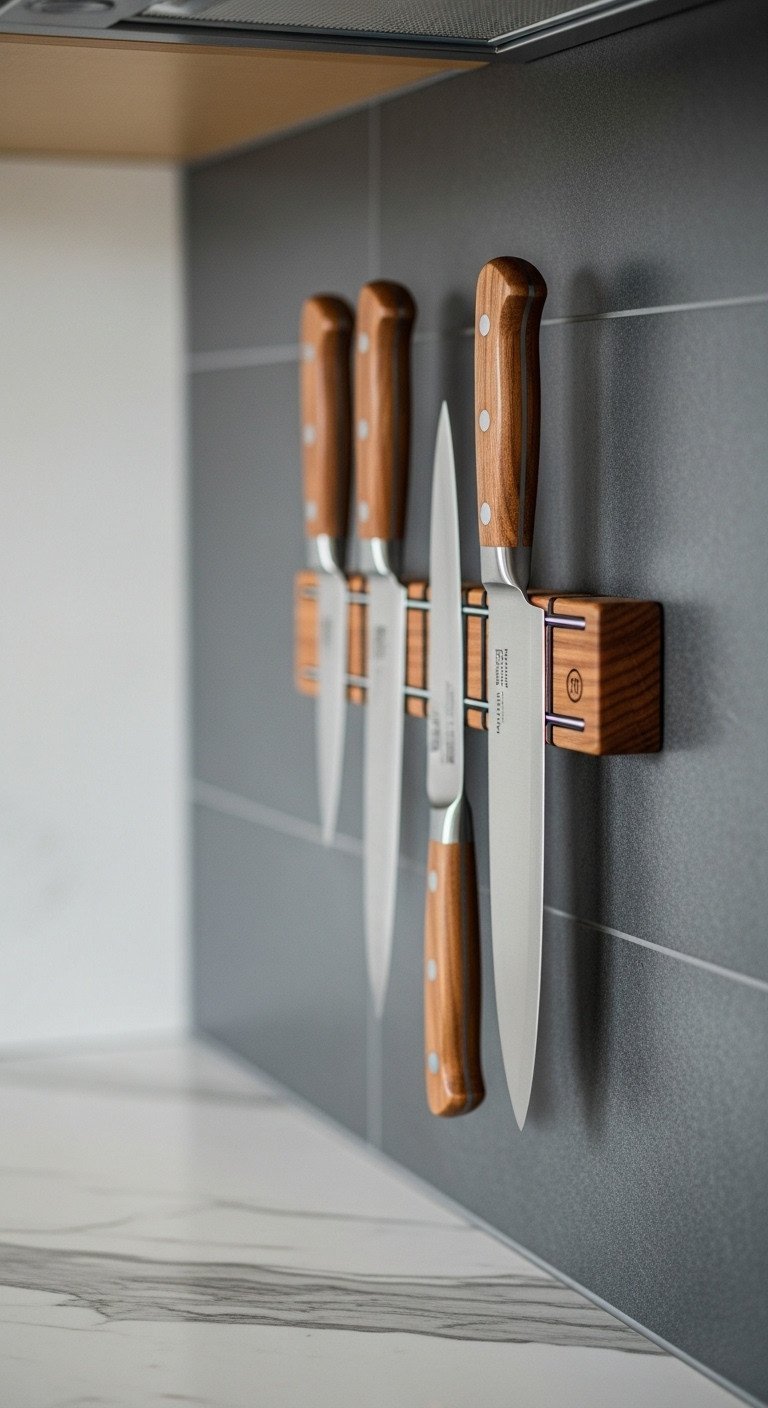
Pin this space-saving idea for a more organized kitchen!
Ditch the clunky countertop knife block for a sleek, wall-mounted magnetic knife strip. This modern kitchen wall decor idea provides safe, accessible storage for your chef’s knives, freeing up valuable prep space. Choose a wood or stainless steel finish to complement your kitchen’s style.
Materials Needed:
- A high-quality magnetic knife strip (wood or stainless steel) with strong magnets
- A drill
- A level
- Wall anchors and screws appropriate for your wall type (tile, drywall, etc.)
- A pencil
Step-by-Step Directions:
- Choose a Safe Location: Select a spot on your wall that is easily accessible while you are cooking but out of reach of children and not in a busy pathway. A spot over the counter near your prep area is ideal.
- Mark Your Holes: Hold the knife strip against the wall. Use a level to make sure it’s perfectly straight. Use a pencil to mark where the mounting screws will go.
- Drill Pilot Holes: Remove the strip and drill pilot holes on your marks. If you are not drilling into a stud, insert wall anchors designed for your wall’s material.
- Mount the Strip: Align the knife strip with the holes and use a screwdriver or drill to fasten the screws, securing it tightly to the wall.
- Arrange Your Knives: Place your knives on the strip with the handles down for safety and easy grabbing. Space them out evenly for a clean, organized look.
- Lesson Learned: Don’t cheap out on a magnetic knife strip. A high-quality one with a strong, continuous magnet is a safety essential to ensure heavy knives don’t slip.
6. Display a Cutting Board Collection
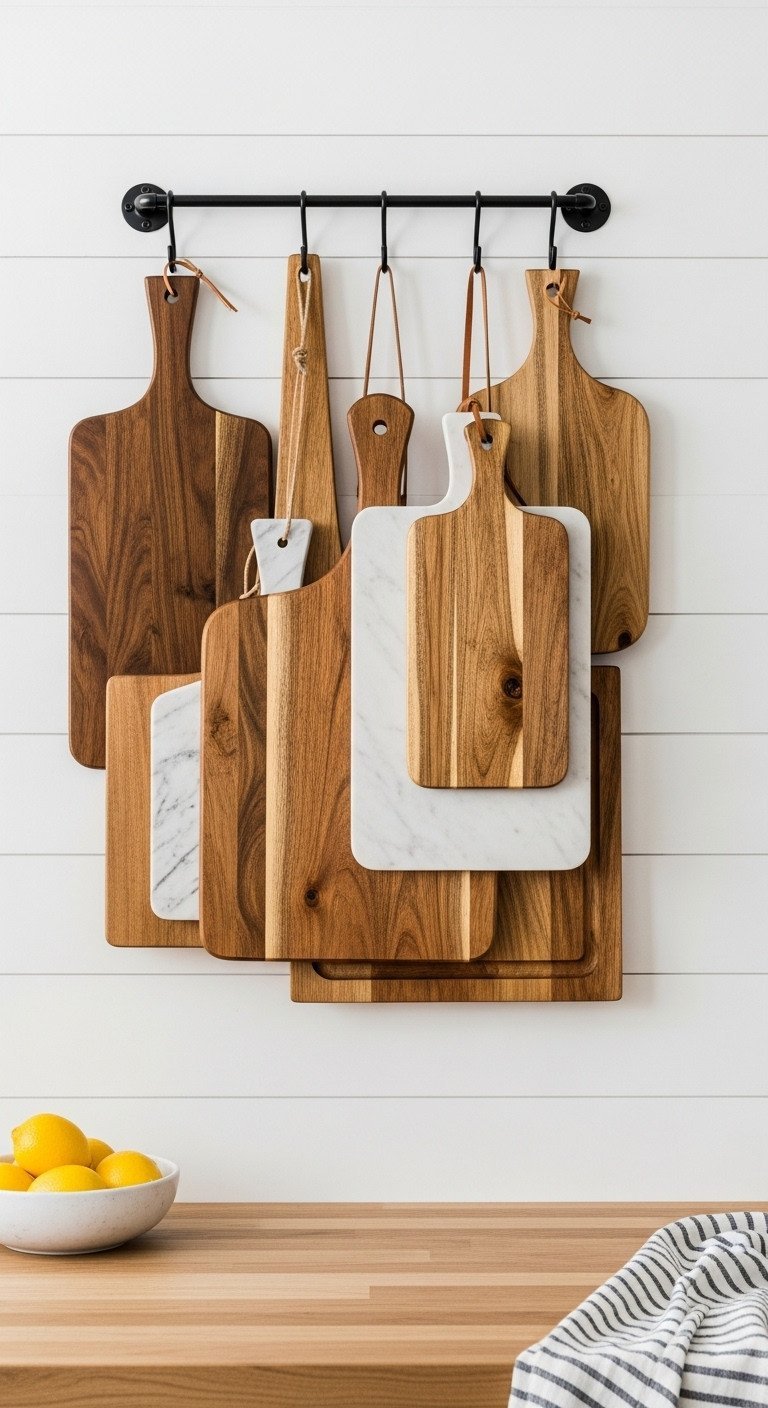
Save this warm and rustic kitchen decor idea!
Your collection of beautiful wood and marble cutting boards shouldn’t be hidden in a cabinet. Displaying them on a metal wall rail with sturdy S-hooks turns everyday items into a warm, textural art installation. This is a perfect example of functional decor that adds rustic charm.
Materials Needed:
- A collection of 3-5 cutting boards in various shapes, sizes, and materials (wood, marble, slate)
- A sturdy metal wall rail (like an IKEA Kungsfors or similar)
- Heavy-duty S-hooks
- A drill, level, and stud finder
- Screws and wall anchors
Step-by-Step Directions:
- Prep Your Boards: Ensure your cutting boards have a hole for hanging. If they don’t, you can easily drill one or attach a leather loop to the handle.
- Install the Rail: Using a stud finder and level, install the metal rail on your empty wall. Follow the same procedure as installing a pot rack, ensuring it’s securely anchored to studs.
- Arrange the Hooks: Slide the S-hooks onto the rail.
- Hang and Layer: Hang your cutting boards from the hooks. Start with the largest board in the back and slightly off-center. Layer smaller boards in front of it, overlapping them slightly to create depth and visual interest.
- Mix Materials: Alternate between wood and marble or different shades of wood to create a more dynamic and textured display.
- Pro-Tip: This is a fantastic way to display and store beautiful but bulky boards that would otherwise take up too much cabinet or counter space.
7. Paint a Chalkboard Accent Wall
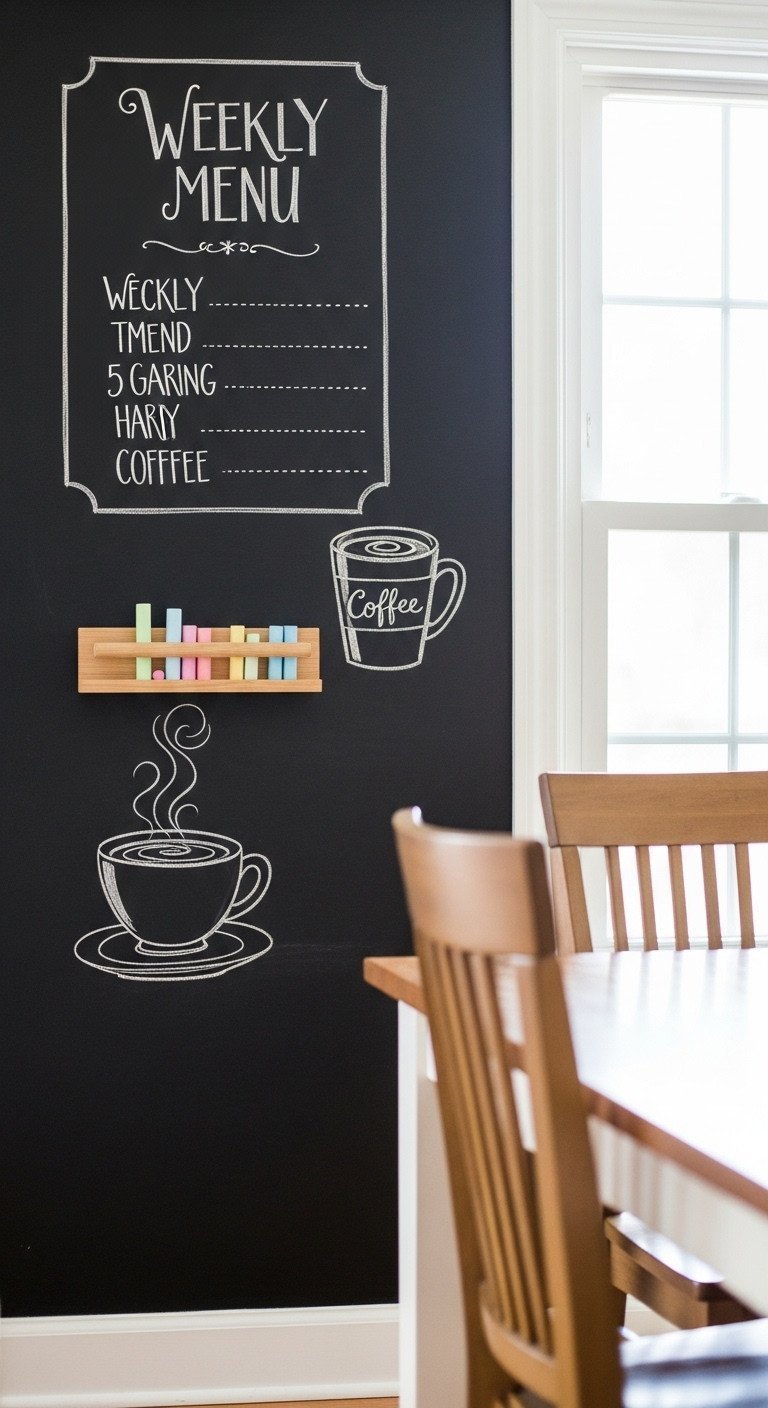
Pin this fun and functional idea for your family kitchen!
An accent wall painted with chalkboard paint is a high-impact, low-cost DIY project that’s both fun and functional. It’s the perfect spot for a family command center where you can write down grocery lists, weekly menus, or just let the kids unleash their creativity with some chalk.
Materials Needed:
- Can of chalkboard paint
- High-density foam roller for smooth application
- Painter’s tape
- Drop cloths
- Fine-grit sandpaper (220-grit)
- Chalk and a chalk eraser
Step-by-Step Directions:
- Prep the Wall: Clean the wall thoroughly and let it dry. Patch any holes and sand them smooth. Tape off the ceiling, baseboards, and adjacent walls with painter’s tape.
- Apply the First Coat: Stir the chalkboard paint well. Using the foam roller, apply a thin, even first coat. Let it dry completely according to the manufacturer’s instructions (usually 3-4 hours).
- Lightly Sand: Once dry, lightly sand the entire surface with fine-grit sandpaper to knock down any bumps, then wipe away the dust with a damp cloth.
- Apply Subsequent Coats: Apply a second, and if needed, a third coat, repeating the drying and light sanding process between each.
- Cure the Wall: This is the most important step! Let the paint cure for the time recommended on the can (often 3 days). Do not write on it before it’s fully cured.
- Season the Surface: Before first use, “season” the entire wall by rubbing the side of a piece of chalk over the whole surface, then erasing it. This prevents your first drawings from being “burned in” forever.
- Pro-Tip: For a cleaner look and less dust, invest in dustless chalk or liquid chalk markers.
8. Hang a Single Piece of Large-Scale Art

Save this simple but high-impact decor idea!
Sometimes the simplest solution is the most effective. Hanging a single piece of large-scale art on an empty kitchen wall creates an instant focal point without adding any clutter. Choose a bold abstract canvas or a large framed print that pulls in colors from the rest of your kitchen for a sophisticated, minimalist design statement.
Materials Needed:
- One large piece of framed art or canvas (at least 24×36 inches or larger, depending on wall size)
- Heavy-duty picture hanging hardware (e.g., French cleat, wall anchors rated for the art’s weight)
- A tape measure
- A level
- A stud finder
Step-by-Step Directions:
- Measure Your Wall: Determine the center point of your empty wall space. This is where the center of your art should generally be.
- Determine Hanging Height: The general rule is to hang art so its center is at eye level, around 57-60 inches from the floor. If hanging over a table or bench, leave 6-8 inches of space between the furniture and the bottom of the frame.
- Find a Stud: If possible, locate a stud near the center point to anchor your hardware for a secure hold.
- Install Hardware: Following the instructions for your specific hanging hardware, install it on the wall. Use a level to ensure it’s perfectly straight.
- Hang the Art: Carefully hang your art piece on the hardware. Step back to ensure it looks centered and level, and make minor adjustments as needed.
- Pro-Tip: The art should take up about two-thirds the width of the wall space it’s occupying. A small piece on a large wall will look lost, so when in doubt, go bigger.
9. Use a Mirror to Create Space and Light
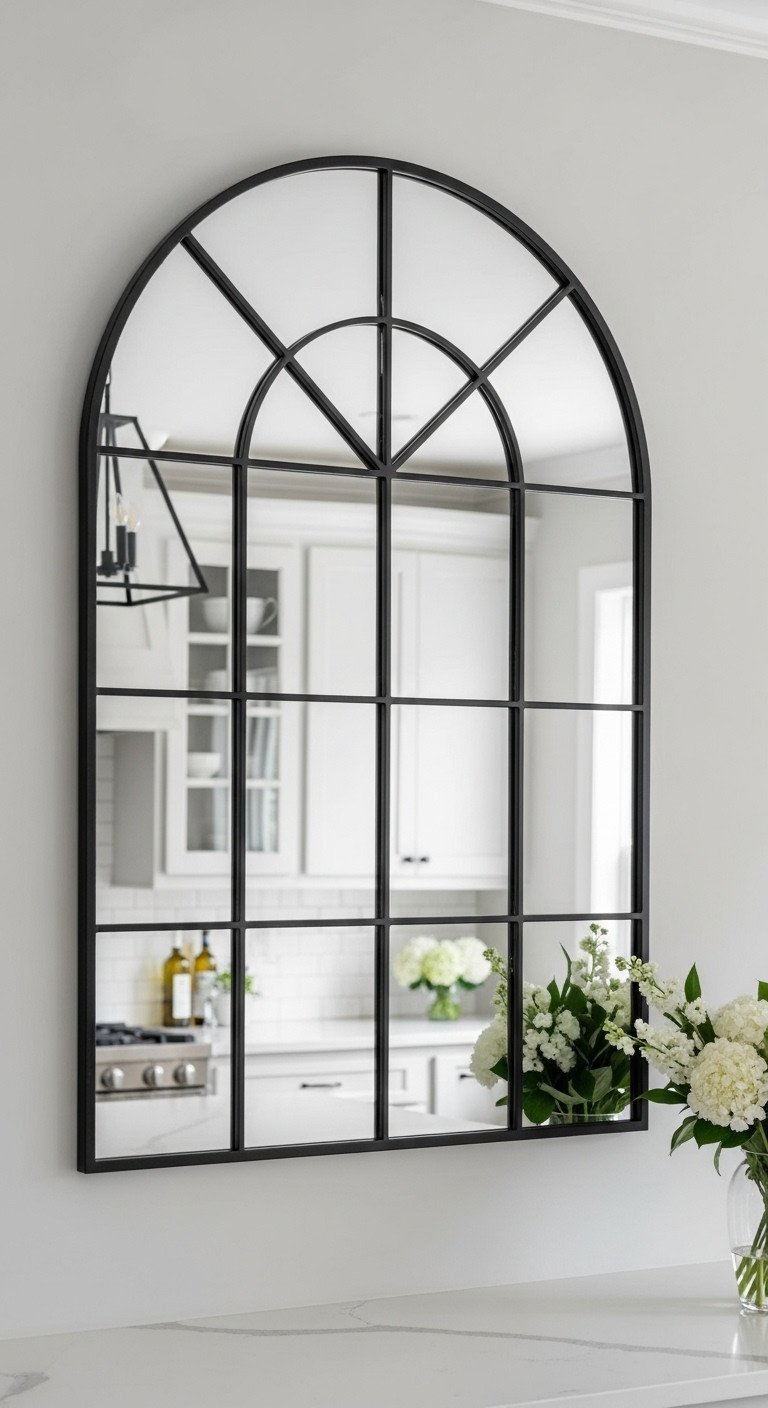
Pin this brilliant trick for making a small kitchen feel bigger!
If you have a small or dark kitchen, a large wall mirror is your best friend. It creates an illusion of expanded space and reflects light around the room, making it feel significantly brighter and more open. Choose a mirror with a decorative frame, like an arched windowpane style, to make it feel like a piece of art.
Materials Needed:
- A large mirror with a decorative frame that matches your kitchen style
- A stud finder
- Heavy-duty hanging hardware appropriate for the mirror’s weight (e.g., a French cleat system)
- A drill, level, and tape measure
Step-by-Step Directions:
- Strategic Placement: The key to using a mirror effectively is its placement. Position it on a wall where it can reflect a source of natural light, like an opposite window, or a beautiful feature, like a pendant light.
- Find the Studs: Mirrors are heavy. Use a stud finder to locate studs and plan to anchor your hardware into them for maximum security.
- Measure and Mark: Following the eye-level rule (center at 57-60 inches), hold the mirror up to the wall (with a helper!) to determine the perfect height. Mark where the hanging hardware needs to be installed.
- Install Hanging Hardware: Securely install the hanging hardware into the wall studs using your drill. Ensure it is perfectly level.
- Hang the Mirror: Carefully lift and hang the mirror onto the wall-mounted hardware. Clean off any fingerprints for a sparkling finish.
- Lesson Learned: Consider what your mirror will reflect. A mirror reflecting a cluttered countertop will only double the clutter. Make sure it reflects something beautiful or a source of light.
10. Cultivate a Vertical Herb Garden
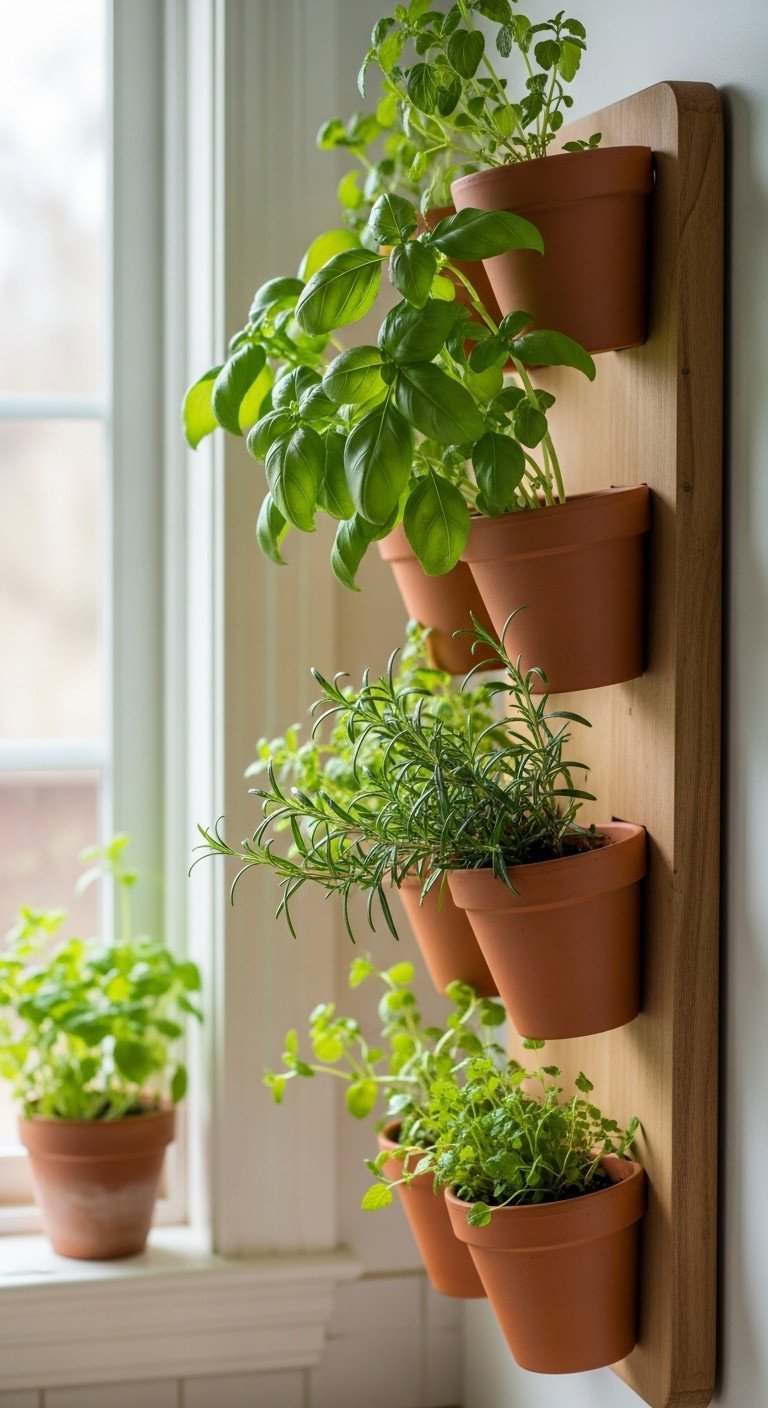
Save this fresh idea for your kitchen wall!
Bring life, color, and fresh flavor into your kitchen with a vertical herb garden. This living decor is both beautiful and incredibly functional, giving you fresh basil, mint, and rosemary right at your fingertips. A wall-mounted planter system keeps your counters clear and takes advantage of a sunny spot.
Materials Needed:
- A wall-mounted planter system or several individual wall planters
- Small pots that fit your planter system
- Potting soil
- A selection of your favorite herbs (buy small starter plants for ease)
- Drill, screws, and wall anchors
- A level
Step-by-Step Directions:
- Choose a Sunny Spot: Most herbs need at least 4-6 hours of sunlight per day. Choose an empty wall that gets plenty of natural light.
- Install Your Planter System: Following the manufacturer’s instructions, use your drill and level to securely mount the planter system to the wall.
- Pot Your Herbs: Gently transfer your herb plants from their nursery containers into the small pots, adding fresh potting soil as needed.
- Arrange Your Garden: Place the potted herbs into the wall planter. Consider the growth habits—place trailing herbs like oregano at the bottom and taller herbs like rosemary at the top.
- Water and Care: Water your herbs as needed (be careful not to overwater) and enjoy having fresh ingredients right at your fingertips.
- Pro-Tip: If your kitchen doesn’t get enough natural light, you can install a small, full-spectrum LED grow light strip above your vertical garden to keep your plants happy.
11. Showcase Decorative Plates

Pin this classic and charming wall decor idea!
For a touch of vintage charm, display a collection of decorative porcelain plates. This timeless decor idea is perfect for a farmhouse or classic kitchen style. Arrange plates of different sizes in an organic cluster to create a beautiful, three-dimensional piece of wall art.
Materials Needed:
- A collection of decorative plates
- Spring-style wire plate hangers or adhesive disc plate hangers
- Picture hanging hooks and nails
- A tape measure and level
- Craft paper and painter’s tape for planning
Step-by-Step Directions:
- Plan the Arrangement: Trace your plates onto craft paper, cut out the circles, and tape them to the wall. This allows you to perfect your layout—be it a symmetrical grid or a more organic cluster—without making unnecessary nail holes.
- Choose Your Hangers: For lighter plates, adhesive disc hangers are invisible. For heavier or more valuable plates, traditional spring-style wire hangers are more secure.
- Attach Hangers to Plates: Securely attach your chosen hangers to the back of each plate according to the product’s instructions.
- Mark and Hang: Start with the central or largest plate in your arrangement. Mark its hanging point through the paper template. Hammer in a picture hook. Remove the paper and hang the plate.
- Build Out the Display: Continue hanging the rest of your plates, using the paper templates as your guide and checking for level and spacing as you go.
- Lesson Learned: When creating a cluster, lay the plates out on the floor first to get the spacing right. Overlap the edges of your paper templates slightly to create a tight, professional-looking group.
Key Takeaways: Your Quick Guide to a Beautiful Kitchen Wall
- Embrace Both Form & Function: The best empty kitchen wall ideas blend style with storage. Think open shelving, pot racks, or a coffee bar.
- Go Big or Group Together: On a large wall, use a single large piece of art or a mirror. For smaller items, group them in a collection (gallery wall, plates, cutting boards) to create a larger visual impact.
- Always Anchor to Studs: For anything heavy like shelves, mirrors, or pot racks, using a stud finder is a non-negotiable safety step.
- Plan Before You Hang: Use paper templates on the wall to perfect the layout for gallery walls or plate collections before you make a single hole.
- Add Life: A vertical herb garden or a small plant on a shelf adds color, texture, and a touch of nature to the heart of your home.
People Also Ask About Empty Kitchen Wall Ideas
What can I put on a large empty kitchen wall?
For a large empty kitchen wall, think in a large scale to maintain proportion. A single, oversized piece of art, a floor-to-ceiling gallery wall, or a bold wallpaper pattern are excellent choices. You could also install a long bank of open shelving or a large piece of functional furniture like a shallow hutch or sideboard for a high-impact solution.
How can I decorate my kitchen wall on a budget?
Decorating a kitchen wall on a budget is easy with a little creativity. Frame free printable art from online sources, paint a dramatic accent wall with a single can of paint, or create a display using your own beautiful kitchen items, like a collection of wooden cutting boards or thrifted vintage plates. Shopping your own home first is the best budget-friendly tip.
Is it okay to hang pictures in a kitchen?
Yes, it is perfectly fine to hang pictures in a kitchen with a few precautions. To protect them from moisture and grease, it’s best to frame photos and prints under glass or acrylic. Avoid hanging valuable or delicate artwork, like an unsealed canvas, directly above a heat source like a stove or a high-steam area like a kettle.
How do I decorate a rental kitchen wall without drilling holes?
For a rental kitchen, focus on non-permanent solutions. Use high-quality removable adhesive hooks and strips to hang lightweight frames and decor. Apply peel-and-stick wallpaper or backsplash tiles for a high-impact, temporary change. You can also lean a large mirror or framed artwork against the wall from a countertop or the floor.
Final Thoughts
Your kitchen is waiting for its final, personal touch. That once-intimidating empty wall is now a canvas ready for your story, a chance to inject personality, warmth, and function into the heart of your home. Whether you opt for smart storage, a personal gallery, or a bold accent, the right choice will make your space feel complete.
Which of these ideas sparked your imagination the most? We’d love to hear what you’re planning in the comments below
Last update on 2025-12-14 at 00:50 / Affiliate links / Images from Amazon Product Advertising API
